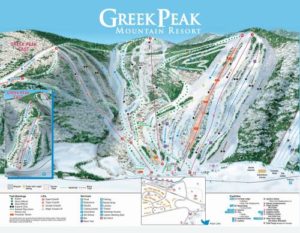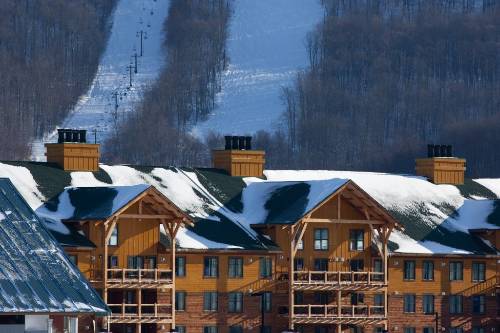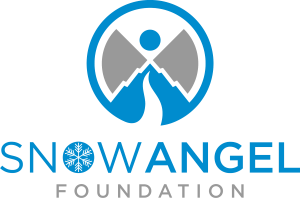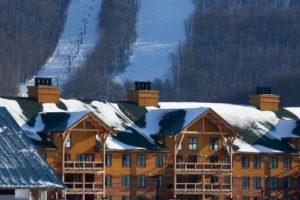
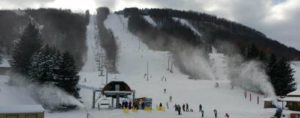
CORTLAND, NY – Sadly, I’ll never get to say, “I’ll take Mythology for a thousand please, Alex,” (as Jeopardy’s long-time host has now gone to that Great Game Show in the Sky), but I would have run the category.
Western Civ is a long suit of mine, and still the best way to educate young minds about philosophy, history, civics, and yes, writing. So it was with juuuuuuust a little pedanctic delight that I regaled my ski buddy with the tales of Homer and Herodotus as we made our way around Cortland, New York’s Greek Peak.
A local favorite and hideaway for upstate New York skiers and boarders, Greek Peak, founded in 1958, is now poised to make a huge jump in exposure due to its joining the Indypass. Once Covid eases Greek Peak is sure to not only see a lot of new faces from all across the country, but keep them as repeat business.
There’s so much to like at Greek Peak. It makes the most of its 950 foot vertical descent by cutting its toughest runs into the teeth of the best terrain, and expert runs are spread all across the resort. There’s plentiful snow; year after year the Syracuse area leads the country in total of snowfall and that means endless powder. There’s even night skiing, and – best of all – Greek Peak keeps a reasonable price point. Plus it’s gorgeous here: the Finger Lakes of New York dazzle year round as a sportsman’s paradise, but with winters as fantastically long and cold as they are in I-90, skiing has always had a long and storied history. That’s why the mountain and resort have enjoyed such goodwill for their entire 63 years.
Greek Peak is actually three summits set roughly side by side, and looking at the trail map with the right kind of eyes it does resemble the head of Poseidon’s trident: three sharp, perfectly-spaced points. That means there is plenty of room to spread out, and everyone has at least one way down from each of the three summits.
Highlight runs of the day included Alcmene – she’s the mother of Hercules, for those of you scoring at home – Iliad, Zeus, and Hercules. (There were races on Odyssey, and Spartan, and we hope to see them when we return.)
Also make a point of checking out the new Greek Peak East section, accessible from Chair 4 via a trail called Arcadian Gate. (I sound like that Ephialtus dude talking to Xerxes about how to betray the Spartans at Thermopylae. “Take the Arcadian Gate over to Mars Hill, then bang a left at the black diamond sign for Arethusa Way…”) While small, there tend to be good mogul fields on Greek Peak East, and the lift line features a last-minute, super-steep, bumpy double fall line that’s a shot of adrenaline to end the run. Like staying atop a bucking bronco, the further you go down the lift line, the gnarlier the ride becomes. Personally I like it – you have to keep grinding all the way back to the chairlift.
A proving ground if you need it and cruisers when you want low impact, Greek Peak shows you many faces all day and dazzles you with vibrant après all evening. Even though Covid has cut down on the usual parking lot scene, there’s still a warm, friendly, family buzz. And now, as an Indypass resort, it will be spoken of in the same conversation as Magic, Cannon, and Jay Peak in the east – *sterling company* – but also dozens of other excellent resorts and local favorites from across the country. Once Covid is gone, Indypass looks the best deal on the market for value, and Greek Peak is easy to get to, so it should see plenty of action all winter.
We caught up with Drew Broderick, Greek Peak Resort’s Vice President of Sales and Marketing for a chat about how things are running this year, as well as some history of the region. We’ll have a longer piece on Greek Peak later this season. We’ll break down the trails, explore the resort, chat with the locals, and who knows? Maybe I’ll even get in a reference to the Second Book of the Poetics of Aristotle in there. So study up, there will be a quiz later.
JF: Tell us about the history of the mountain, and why is it called Greek Peak?
DB: We opened in 1958, and the original owner, Al Kryger, liked Greek mythology. So he gave all the trails names like Zeus and Hercules…Olympian and Spartan. We do have a few trails named after friends of ours and of the mountain – “Friends of Greek Peak” so to speak, to honor them. Wendy’s Way, for example.
JF: Now Al Kryger owned and operated it until fairly recently didn’t he?
DB: Yes. It was in 2013 John Meier and Marc Stemerman, two former season pass-holders, became partners and bought the resort. And then in 2019, Marc retired from the ski business, and Christine, John’s wife, became John’s new partner in the resort.
JF: Break down the mountain for us. Total number of trails?
Iconic runs? What’s the best race course?
DB: We have 65 trails, eight total lifts, including one high-speed quad. There are two terrain parks now, but there will soon be three.
Alcmene and Iliad are probably our most popular runs, but I’d say Castor is also a favorite. It’s a green circle, but it begins at the summit of the entire resort, the middle peak. We like this, because beginner skiers are not relegated to the bottom half of the mountain; everyone can go to the top and find a way down.
Odyssey is one of the race courses, and Christy’s Run has gates for our guests that would like to get in some NASTAR timing.
JF: Covid has forced everyone to adapt. What clever ideas have you employed at the mountain to overcome Covid’s obstacles?
DB: We have a system where if someone does not want to go inside a building – during their entire stay at the mountain – they do not have to. We built outside ticket windows, and we have outdoor food and beverage, including Trax deck, a heated, 6000 sq. ft. outside deck. And then we added temporary outside rest rooms. Also for lessons, we arranged for a family of up to 7, no matter what any of their ski levels are, we can teach all them as a unit so they don’t have to come into contact with any other people they did not come with or do not live with.
JF: What’s the biggest Covid challenge you’ve overcome and how?
DB: It’s face coverings, but it’s resolving itself organically. Many  skiers and snowboarders wore face masks already. For the others, it took a little while to remember to wear it unless in motion on the mountain. We added staff to gently remind folks to put their mask on if they forget, but people are getting really good about it, and no one wants to be the one to ruin it for everyone, so they are really cooperating.
JF: How expensive were the Covid protocols to implement?
DB: (Laughing) I don’t know per se, but it’s a substantial expense. We have signage and more people and new computer systems. There are even new cell phone apps for capacity in the lodge. We know at any time how many people are in our buildings. That tech is not cheap.
JF: What can visitors expect on the mountain in terms of overall experience: parking, food, reservations, tickets, etc.?
DB: They can buy tickets on-line, but we don’t require it, though we do recommend it. They can also get tickets here at the mountain, outside or inside.
We require reservations for lessons, and we suggest they buy rentals on line, but don’t have to. Regarding food, we have a variety of outdoor and indoor dining. Trax, the busiest restaurant, will check you in by hostess if they can fit you in. If not, we’ll put you on a list.
JF: Is it the kind of thing where they can text you and you keep skiing until you text them to come in?
DB: No, we can’t do that. Turn around is so fast, it’s not a “go for a run” kind of deal. We’ll get them in quickly.
JF: What advantages do smaller, regional places have over the mega-resorts re: Covid? Any advice for other smaller places trying to make it through all this mess?
DB: Absolutely we have an advantage. Living in New York with the restrictions for travel, it’s been a great opportunity for the New York ski industry, because many people that would go to out of state are staying home and getting to tour New York’s mountains. And we are less expensive than buying plane tickets for out west. You get a lot of value out of our regional and local mountains.
JF: How bad a hit did you take last spring? How are your numbers for the year so far?
DB: We opened on 11/15/19 and closed on 3/15/20 – an average season in terms of number of days open. But we had to close Hope Lake Lodge for three months.
Three months of no hotel was a pinch, but we turned it into a community grocery store, bringing a silver lining to that cloud for a lot of people, not just us. We got another silver lining back: this season, everyone is coming out. We’ve done more lessons than ever, and our maximum capacity has allowed us to have excellent attendance while totally complying with state guidelines.
JF: How is Indypass working out?
DB: They have such a great program. We love Indypass, and it’s growing like crazy. Word is spreading like wildfire about the pass’s benefits, and people are really responding.
